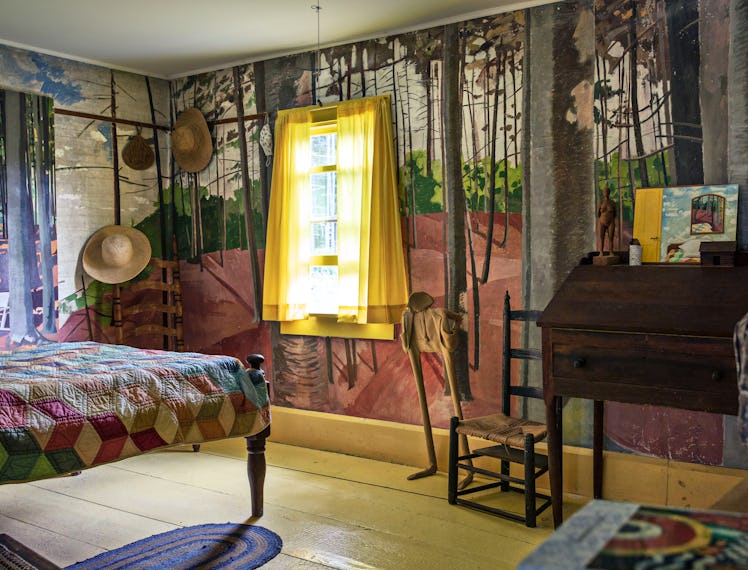An Artist’s Eclectic Retreat in Maine

Part of the appeal of Maine, as opposed to some of the tonier coastal enclaves in the Northeast, is its rugged spirit. If you don’t love nature, this is not the place for you. In contrast to the imposing stone mansions of Newport or the climate-controlled estates of Southampton, to live in Maine is to embrace the misty sea air, the sounds and smells of the pine forests. In some of the most welcoming summer residences, indoors is merely a suggestion. The photographer Maura McEvoy, troubled by the sight of the landscape being developed at a rapid clip, was inspired to capture a version of the state that is still being passionately preserved by those who appreciate its idiosyncratic history. The result is The Maine House, out June 22nd, which offers a look into stunning “houses created by the people who live in them, distinctive for their ingenuity, originality and fierce individuality,” as fellow New Englander Kathleen Hackett writes in the book’s introduction. They represent, as Hackett so deftly puts it, “the kind of visual wealth that money just can’t buy.” Here, an exclusive look at the artist Lois Dodd’s converted farmhouse in the Mid-Coast region.
The below is excerpted with permission from The Maine House By Maura McEvoy and Basha Burwell, text by Kathleen Hackett (Vendome Press, 2021).
The exterior of Dodd’s home in summer. One of her grandchildren installed a solar panel on the roof of the garden shed.
Lois Dodd made one of her most notable bodies of work during the Watergate hearings in 1974. “I was painting in the woods near my house and ran back and forth to listen to the radio. It was like having office hours,” she says. For more than half a century, the realist painter has found the land surrounding her Mid-Coast Maine farmhouse to be as fertile and endlessly exciting a subject as any. “I paint what I am looking at,” says the plainspoken nonagenarian, who was part of the wave of postwar New York artists—her former husband, Bill King, and Alex Katz among them—to explore the coast of Maine in the 1950s. “The real estate was so cheap compared to Long Island, so we thought, why not?” she says.
An imperfect kitchen floor inspired Dodd to mask it with paint she sprayed and dripped indiscriminately.
Works by friends hang in the dining room, an addition to the original farmhouse, in which the clapboard wall was once the exterior of the house.
Such pragmatism and fearlessness are on full display in the cedar-shingled house and barn where she has settled in for summers since 1964. It would be easy to assume that Dodd frames up all the action, as evinced by her paintings of window frames, sides of clapboard houses, woodland paths, geometric flowers, and laundry blowing in the breeze, outdoors. But a decade after making those paintings of the woods, she mixed up some powdered pigment left over from her days as a student at Cooper Union and set to work on the walls in the north corner of the house.
Dodd surrounds herself with art everywhere; on walls, shelves, desks and bureaus.
A series of portraits and still lives lines Dodd’s studio walls
The artist’s studio is ten steps from the house in a detached barn, where the only company is an occasional honeybee and a radio.
“It was cold in that room until I tore down the kitchen wall and put in a stove. Then I decided it needed another window and some woods. That was fun,” she says. Concerned the linoleum that once lined the kitchen floor would create rot underneath, she ripped it up and was left with black splotches from the glue holding it down. “I thought, I’ll just do this spray-painty thing on it,” she says. The most recent addition came in the form of red nail polish, applied by a houseguest.
Works by artist friends, among them Nancy Wissemann-Widrig, Jeff Epstein, and Barbara Sullivan, line a living room wall.
In Dodd’s studio, an early nineteenth-century New England barn, there are dozens of paintings neatly lining the whitewashed walls and piles of palettes hanging from nails. A flat file heaves with drawings. Her easel sits in the middle of the room, notably unencumbered—all the easier to extricate herself and get out into the surrounding woods and fields. “Being in Maine is what got me working outdoors,” she says. “And for a time, I thought I would exhaust the subject and have to make a move. But that never happened.”
Courtesy of Vendome Press
This article was originally published on